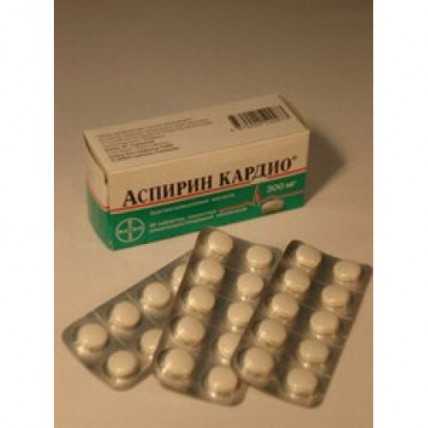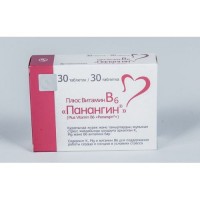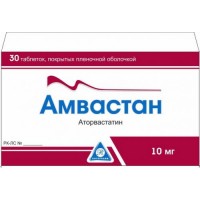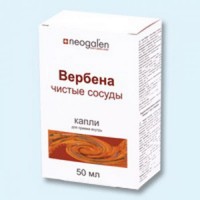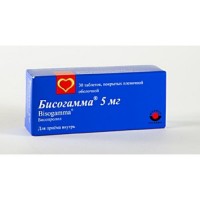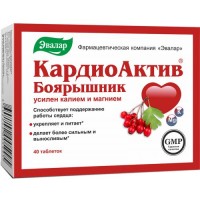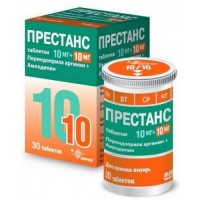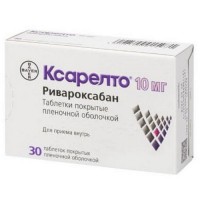Aspirin Cardio 30s 300 mg coated tablets
- $9.20
The instruction for medical use
of medicine
Aspirin kardio
the Trade name
Aspirin kardio
the International unlicensed name
Acetylsalicylic acid
the Dosage form
of the Tablet, 100 mg and 300 mg covered with a kishechnorastvorimy cover
Structure
One tablet contains
active agent - acetylsalicylic acid of 100 mg or 300 mg,
excipients: cellulose powder, starch corn, eudragit L30D, polysorbate 80, sodium lauryl sulfate, talc, triethyl citrate.
The description
the Round, biconvex, slightly rough, mown to edge tablets of white color, on a break - the homogeneous mass of white color surrounded with a cover of the same color
Pharmacotherapeutic group
Anticoagulants. Inhibitors of aggregation of thrombocytes iskl. heparin. Acetylsalicylic acid
the ATX B01AC06 Code
the Pharmacological
Pharmacokinetics Later properties of intake acetylsalicylic acid (ASK) is quickly and completely absorbed from a GIT.
During absorption and right after it acetylsalicylic acid turns into the main active metabolite - salicylic acid.
The maximum concentration of acetylsalicylic acid in blood plasma are reached in 10-20 min., the maximum concentration of salicylic acid - in 0.3-2 h.
Thanks to the fact that the kishechnorastvorimy cover of tablets of Aspirin кардио® is resistant to effect of acid an exit of active substance occurs not in a stomach, and in the alkaline environment of intestines. At the expense of it absorption of acetylsalicylic acid is delayed for 3-6 hours in comparison with the tablets which are not covered with a kishechnorastvorimy cover.
Acetilsalicylic and salicylic acids contact substantially proteins of plasma and are quickly distributed in fabrics.
Salicylic acid is emitted in breast milk and gets through a placental barrier.
Salicylic acid is metabolized, mainly, in a liver with formation of metabolites - the salitsilurat, a salitsilovofenolny glucuronide, a salitsilatsilovy glucuronide, gentisinic and gentizurovy acids.
Removal of salicylic acid is dose-dependent.
Elimination half-life at administration of drug in low doses makes 2-3 h, at administration of drug in high doses - 15 h. Salicylic acid and its metabolites are removed, mainly, by kidneys.
The pharmacodynamics
is the cornerstone of the mechanism of effect of acetylsalicylic acid irreversible inhibition of cyclooxygenase (TsOG-1) therefore synthesis of A2 thromboxane is blocked and aggregation of thrombocytes is suppressed. The Antiagregantny effect is most significant in thrombocytes as they are not capable to synthesize cyclooxygenase repeatedly.
It is considered that acetylsalicylic acid has also other mechanisms of suppression of aggregation of thrombocytes that broadens area of its use in various vascular diseases.
Acetylsalicylic acid belongs to group of non-steroidal anti-inflammatory drugs, and possesses anesthetic, febrifugal and anti-inflammatory action.
Higher doses are applied to removal of pain and insignificant feverish states, such as cold and flu, to decrease in temperature, reduction of muscular and articulate pains and also in acute and chronic inflammatory diseases, such as pseudorheumatism, osteoarthritis and ankylosing spondylitis.
Indications
- for reduction of risk of death at patients with suspicion of an acute myocardial infarction
- for reduction of risk of incidence and mortality at the patients who had a myocardial infarction
- for secondary prevention of a stroke
- for reduction of risk of development of the tranzitorny ischemic attack (TIA) and a stroke at patients with TIA
- for decrease in incidence and mortality in stable and unstable stenocardia
- for prevention of a thrombembolia after operations and invasive interventions on vessels (for example, chrezkozhny transluminal catheter angioplasty, aortocoronary shunting, endarterectomy of carotids, arteriovenous shunting)
- for prevention of a deep vein thrombosis and a pulmonary embolism at a long immobilization (for example, after big surgical intervention)
- for reduction of risk of development of an acute myocardial infarction with cardiovascular risk factors (for example, diabetes, a lipidemia, arterial hypertension, obesity, smoking, advanced age)
the Route of administration and doses
For intake.
Aspirin tablets kardio, covered with a kishechnorastvorimy cover, it is necessary to accept before food, washing down with a large amount of liquid.
For reduction of risk of death at patients with an acute myocardial infarction
the Initial dose of 100-300 mg (the first tablet needs to be chewed for faster absorption) has to be accepted by the patient as soon as possible after there was a suspicion on development of an acute myocardial infarction.
In the next 30 days after development of a myocardial infarction the dose of 100-300 mg/day has to be supported.
In 30 days it is necessary to consider need of further therapy for prevention of development of a repeated myocardial infarction.
For reduction of risk of incidence and mortality at the patients who had a myocardial infarction
of 100-300 mg/days
For secondary prevention of a stroke
of 100-300 mg/days
For reduction of risk of TIA and a stroke at patients with TIA
of 100-300 mg/days
For decrease in incidence and mortality in stable and unstable stenocardia
of 100-300 mg/days
For prevention of a thrombembolia after operations and invasive interventions on vessels
of 100-300 mg/days
For prevention of a deep vein thrombosis and a pulmonary embolism
of 100-200 mg/days or 300 mg every other day
For reduction of risk of development of an acute myocardial infarction
of 100 mg a day or 300 mg every other day.
Side effects
the Listed below side effects are based on the given spontaneous post-marketing account and on experience of use of all forms of Aspirin, including oral forms for a short and long course of treatment.
In this regard their representation on frequency according to categories CIOMS III is not possible.
Often:
- dyspepsia, abdominal pains and pains in gastrointestinal area
it is rare:
- the inflammation of digestive tract, an ulcer of a mucous membrane of a stomach and duodenum (which are extremely seldom potentially leading to gastrointestinal bleedings and perforation with the corresponding clinical laboratory symptoms)
it is rare – very seldom:
- hard cases of bleedings, such as gastrointestinal bleedings, cerebral hemorrhages (especially at patients with uncontrollable arterial hypertension and/or receiving the accompanying therapy by anticoagulating means) which in some cases can have life-threatening character.
Very seldom:
- heavy reactions of hypersensitivity, including an acute anaphylaxis
- passing abnormal liver functions with increase in activity of hepatic transaminases
With an unknown frequency:
- bleedings, such as perioperatsionny bleedings, hematomas, epistaxis (nasal bleeding), bleedings from urinogenital ways, bleeding of gums
- hemolysis and hemolytic anemia at patients with severe forms of insufficiency dehydrogenase glyukozo-6-phosphate
- renal failures and an acute renal failure
- reactions of hypersensitivity with the corresponding clinical laboratory manifestations (an asthmatic syndrome, reactions easy and moderately severe from integuments, airways, digestive tract and a cardiovascular system, including skin rash, a small tortoiseshell, hypostases, a skin itching, rhinitis, a rhinedema, a cardiorespiratory distress syndrome)
- dizziness and a ring in ears that can also be sign of overdose of drug.
Contraindications
- hypersensitivity to acetylsalicylic acid or other salicylates, or to any of drug excipients
- the bronchial asthma in the anamnesis induced by intake of salicylates and substances of similar action, in particular non-steroidal anti-inflammatory drugs (NPVP)
- an acute period of a peptic ulcer
- hemorrhagic diathesis
- a heavy renal failure
- a heavy liver failure
- heavy heart failure
- the combined use with a methotrexate in a dose of 15 mg a week and more
- the last trimester of pregnancy for Aspirin of kardio 100 mg (see the section Pregnancy and Lactation)
- the pregnancy period (all 3 trimesters) for Aspirin of kardio 300 mg (see the section Pregnancy and Lactation)
Medicinal interactions
Contraindicated interactions
the Methotrexate in a dose of 15 mg / in a week and more
Pri simultaneous use of ASK with a methotrexate raises hematologic toxicity of a methotrexate because NPVS reduce renal clearance of a methotrexate, and salicylates, in particular, force out it from communication with proteins of plasma.
The combinations demanding respect for care
the Ibuprofen
the Ibuprofen at simultaneous use with ASK are antagonizirut by its positive influence on thrombocytes.
Patients with the increased risk of cardiovascular diseases have a simultaneous use of an ibuprofen and ASK leads to decrease in its cardioprotective effect.
Anticoagulants, thrombolytic and other antiagregantny drugs
there Is a risk of developing bleedings.
Other NPVS with salicylates in a high dose (3 g/days and more)
Because of synergism of action the risk of formation of ulcers of a mucous membrane of a GIT and bleedings increases.
Selective serotonin reuptake inhibitors
Because of synergism of action the risk of developing bleedings from upper parts of a GIT increases.
Digoxin
due to decrease in renal clearance of ASK increases concentration of digoxin in blood plasma.
Antidiabetic means, for example insulin, sulphonylurea derivatives
High doses of ASK strengthen effect of hypoglycemic drugs due to hypoglycemic effect of acetylsalicylic acid and replacement of derivatives of sulphonylurea from communication with proteins of blood plasma.
Diuretics in a combination with high doses of ASK
the decrease in glomerular filtration as a result of decrease in synthesis of prostaglandins in kidneys Is noted.
System glucocorticosteroids (GKS), except for the hydrocortisone used for replacement therapy of a disease
of Addison Pri of therapy by corticosteroids the level of concentration of salicylates in blood decreases and there is a risk of development of overdose by salicylates after the treatment termination as GKS strengthen removal of the last.
Inhibitors of angiotensin-converting enzyme (APF) in a combination with high doses of ASK
the decrease in glomerular filtration as a result of inhibition of prostaglandins possessing vasodilating action, respectively weakening of hypotensive action Is noted.
Valproic acid
Increases toxicity of valproic acid due to replacement from communication with proteins of blood plasma.
Ethanol
Is noted increase in risk of injury of a mucous membrane of a GIT and lengthening of a bleeding time as a result of mutual strengthening of effects of ASK and ethanol.
Uricosuric drugs, such as benzbromaron, probenetsid
the uricosuric effect owing to competitive renal tubular elimination of uric acid Decreases.
Special instructions
Drug should be used with care at the following states:
- at hypersensitivity to analgetics, anti-inflammatory, antirheumatic drugs and at other types of an allergy
- existence in the anamnesis of cankers of digestive tract, including a chronic or recurrent peptic ulcer or gastrointestinal bleedings
- at combined use with anticoagulants (See the section Medicinal Interactions)
- at patients with renal failures or blood circulations (for example, in a disease of kidneys of vascular character, stagnant heart failure, reduction of volume of the circulating blood, big surgical interventions, sepsis or heavy bleedings) as acetylsalicylic acid can promote further increase in risk of development of injury of kidneys or an acute renal failure
- at the patients suffering from a severe form of insufficiency of the glyukozo-6-dehydrogenase phosphate (G6DP) acetylsalicylic acid can induce development of hemolysis or hemolytic anemia. High doses of drug, fever or presence of acute infections belong to factors which can increase risk of development of hemolysis, for example,
- in an abnormal liver function
the Ibuprofen can interfere with overwhelming effect of ASK on aggregation of thrombocytes. The patients receiving treatment of ASK and accepting an ibuprofen for pain relief should inform on it the doctor.
ASK can provoke a bronchospasm and also cause attacks of bronchial asthma and other reactions of hypersensitivity. Risk factors are presence of bronchial asthma in the anamnesis, hay fever, the polypose of a nose, chronic diseases of a respiratory system and also allergic reactions to other substances (for example, skin reactions, an itching, urticaria).
Owing to inhibiting effect on thrombocytes, Aspirin use kardio it can be connected with the increased risk of developing bleedings. Thanks to the specified ability to suppress aggregation of thrombocytes which remains within several days after administration of drug, acetylsalicylic acid can result in the increased bleeding in time and after surgical interventions (including small surgical interventions, for example, extraction of tooth).
Bleedings can lead to development of an acute or chronic posthemorrhagic/iron deficiency anemia (for example, owing to the latent microbleeding) with the corresponding clinical laboratory signs and symptoms, such as asthenia, pallor of integuments, hypoperfusion.
ASK in low doses reduces excretion of uric acid that can provoke development of gout in predisposed persons.
Use in pediatrics
Exists interrelation between intake of Aspirin and development of a syndrome to Reja when using at children with certain viral diseases. The risk can be increased, at the combined use of the drugs containing ASK, however relationship of cause and effect was not revealed. Development of persistent vomiting in such diseases can be sign of a syndrome to Reja.
The syndrome to Reja is very rare disease which causes damage of a brain and liver and can have a lethal outcome.
In this regard Aspirin kardio should not be applied at children and teenagers 18 years except for cases of special indications are younger.
Use during pregnancy
Inhibition of synthesis of prostaglandins can make negative impact on pregnancy and development of an embryo or fruit. Data of epidemiological researches confirm the increased risk of development of defects and malformation at use of inhibitors of synthesis of prostaglandins in the early stages of pregnancy. At the same time believe that the risk increases at increase in a dose and duration of treatment. Available data do not confirm any interrelation between use of acetylsalicylic acid and increase in risk of premature termination of pregnancy. Available epidemiological data concerning development of malformations are contradictory, however, it is impossible to exclude the increased risk of development of defect – not fusion of an anterior abdominal wall. Prospective use of ASK in the early period of pregnancy (1-4 month) at 14.800 women/children did not reveal any association with the increased frequency of malformations.
Data of preclinical trials showed reproductive toxicity. Prescribing of the drugs containing acetylsalicylic acid in the first and second trimesters of pregnancy is not shown until it is not dictated by emergency.
Taking into account it in the first and in the second pregnancy trimesters Aspirin kardio in a dose of 100 mg can be applied only after carrying out a ratio by the doctor of careful assessment risk/advantage.
At use of the drugs containing acetylsalicylic acid the woman during conception or in the first and in the second trimester of pregnancy, it is necessary to apply lower dose of drug and to conduct a short course of treatment.
In the third trimester of pregnancy all inhibitors of synthesis of prostaglandins can cause in a fruit:
cardiopulmonary toxicity (with premature closing of a botallov of a channel and pulmonary hypertensia)
dysfunction of kidneys which can progress to a renal failure in an oligoamnios,
At mother and a fruit at the end of pregnancy:
possible increase in a bleeding time, antiagregantny effect which can arise even at small doses
suppression of sokratitelny uterine activity that can lead to a perenashivaniye or long childbirth
In this regard ASK is contraindicated to use in the third trimester of pregnancy.
Use in the period of a lactation
Salicylates and their metabolites in small amounts are emitted with breast milk. Accidental intake of salicylates in the period of a lactation does not demand the breastfeeding termination. However at appointment as the doctor of prolonged use of drug or intake of acetylsalicylic acid in high doses the breastfeeding should be stopped.
Features of influence of medicine on ability to run the vehicle or potentially dangerous mechanisms
Considering possible side effects, such as dizziness, it is necessary to be careful when driving or potentially dangerous mechanisms.
The overdose
of Salitsilatnaya intoxication (develops at reception of ASK in a dose more than 100 mg/kg/days on an extent of more than 2 days) can be result of prolonged use of toxic doses of drug as a result of the wrong therapeutic use of drug (chronic intoxication) or single accidental or intended dose of a toxic dose of drug by the adult or child (acute intoxication).
Symptoms of chronic overdose are not specific and are often diagnosed hardly.
The chronic overdose of light severity usually develops only after numerous use of high doses of drug.
Symptoms: dizziness, sonitus, decrease in hearing, the increased sweating, nausea and vomiting, a headache and confusion of consciousness. The specified symptomatology disappears after reduction of a dose of drug. Sonitus can appear at concentration of ASK in blood plasma from 150 to 300 mkg/ml. Heavier symptoms appear at concentration of ASK more than 300 mkg/ml.
Acute intoxication
Symptoms: the main manifestation of acute intoxication is heavy disturbance of an acid-base state which manifestations can vary depending on age of the patient and severity of intoxication. At children the most typical is development of a metabolic acidosis. Weight of intoxication cannot be estimated only by concentration of ASK in blood plasma. Absorption of ASK can be delayed owing to delay of gastric emptying, forming of concrements in a stomach or as a result of reception of the tablets covered with an enterosoluble cover.
Treatment: it is carried out according to the adopted standards and depends on severity of intoxication and a clinical picture and it has to be directed mainly to acceleration of removal of drug and recovery of water and electrolytic balance and an acid-base state.
Overdose from easy to average degree
Symptoms: a tachypnea, a hyperventilation, a respiratory alkalosis (alkalemiya and an alkaluria), the increased sweating, nausea and vomiting.
Treatment: gastric lavage, multiple dose of activated carbon, an artificial diuresis drugs for urine alkalization, recovery of water and electrolytic balance and an acid-base state.
Overdose from average to heavy degree
Symptoms:
- a respiratory alkalosis with a compensatory metabolic acidosis (acidemia and an aciduria)
- a hyper pyrexia
- breath disturbances: a hyperventilation, not cardiogenic fluid lungs, respiratory depression, asphyxia
- disturbances from a cardiovascular system: disturbances of a heart rhythm, arterial hypotension, oppression of warm activity (change of indicators of arterial blood pressure, the electrocardiogram)
- disturbances of water and electrolytic balance: dehydration, a renal failure from an oliguria up to development of a renal failure (hypopotassemia, a hypernatremia, a hyponatremia)
- glucose metabolism disturbance: a hyperglycemia, a hypoglycemia (especially at children), ketoacidosis
- sonitus, deafness
- gastrointestinal bleedings
- hematologic disturbances: from inhibition of aggregation of thrombocytes to a coagulopathy, lengthening of a prothrombin time, a prothrombinopenia
- neurologic disturbances: toxic encephalopathy and oppression of function of the central nervous system (drowsiness, confusion of consciousness, lump, spasm)
Treatment: immediate hospitalization in specialized departments for performing the emergency therapy - gastric lavage, multiple dose of activated carbon, the forced alkaline diuresis, a hemodialysis.
Recovery of water and electrolytic balance and acid-base state, symptomatic therapy.
A form of release and packing
On 14 or 10 tablets in blister strip packaging from a film of polypropylene and aluminum foil.
On the 2nd blister strip packagings containing 14 tablets or on the 3rd blister strip packagings containing 10 tablets place in a box of cardboard together with the instruction for use.
Not to use a period of storage of 5 years after expiry date.
To Store storage conditions at a temperature not above 25 °C.
To store out of children's reach!
Prescription status
Without prescription
of Proizvoditel Bayer Pharm AG, Leverkusen, Germany
the Owner of the registration certificate
of Bayer Pharm AG, Berlin, Germany
Upakovshchik Bayer Bitterfeld GmbH, Germany
the Address of the organization accepting in the territory of the Republic of Kazakhstan
claims from consumers on quality of a product (goods)
of Bayer of KAZ LLP, Timiryazev St., 42,
business center Expo-City, peahens. 15
050057 Almaty, Republic of Kazakhstan,
ph. +7 727 258 80 40, fax: +7 727 258 80 39, e-mail:
To Develop kz.claims@bayer.com
of medicine
Aspirin kardio
the Trade name
Aspirin kardio
the International unlicensed name
Acetylsalicylic acid
the Dosage form
of the Tablet, 100 mg and 300 mg covered with a kishechnorastvorimy cover
Structure
One tablet contains
active agent - acetylsalicylic acid of 100 mg or 300 mg,
excipients: cellulose powder, starch corn, eudragit L30D, polysorbate 80, sodium lauryl sulfate, talc, triethyl citrate.
The description
the Round, biconvex, slightly rough, mown to edge tablets of white color, on a break - the homogeneous mass of white color surrounded with a cover of the same color
Pharmacotherapeutic group
Anticoagulants. Inhibitors of aggregation of thrombocytes iskl. heparin. Acetylsalicylic acid
the ATX B01AC06 Code
the Pharmacological
Pharmacokinetics Later properties of intake acetylsalicylic acid (ASK) is quickly and completely absorbed from a GIT.
During absorption and right after it acetylsalicylic acid turns into the main active metabolite - salicylic acid.
The maximum concentration of acetylsalicylic acid in blood plasma are reached in 10-20 min., the maximum concentration of salicylic acid - in 0.3-2 h.
Thanks to the fact that the kishechnorastvorimy cover of tablets of Aspirin кардио® is resistant to effect of acid an exit of active substance occurs not in a stomach, and in the alkaline environment of intestines. At the expense of it absorption of acetylsalicylic acid is delayed for 3-6 hours in comparison with the tablets which are not covered with a kishechnorastvorimy cover.
Acetilsalicylic and salicylic acids contact substantially proteins of plasma and are quickly distributed in fabrics.
Salicylic acid is emitted in breast milk and gets through a placental barrier.
Salicylic acid is metabolized, mainly, in a liver with formation of metabolites - the salitsilurat, a salitsilovofenolny glucuronide, a salitsilatsilovy glucuronide, gentisinic and gentizurovy acids.
Removal of salicylic acid is dose-dependent.
Elimination half-life at administration of drug in low doses makes 2-3 h, at administration of drug in high doses - 15 h. Salicylic acid and its metabolites are removed, mainly, by kidneys.
The pharmacodynamics
is the cornerstone of the mechanism of effect of acetylsalicylic acid irreversible inhibition of cyclooxygenase (TsOG-1) therefore synthesis of A2 thromboxane is blocked and aggregation of thrombocytes is suppressed. The Antiagregantny effect is most significant in thrombocytes as they are not capable to synthesize cyclooxygenase repeatedly.
It is considered that acetylsalicylic acid has also other mechanisms of suppression of aggregation of thrombocytes that broadens area of its use in various vascular diseases.
Acetylsalicylic acid belongs to group of non-steroidal anti-inflammatory drugs, and possesses anesthetic, febrifugal and anti-inflammatory action.
Higher doses are applied to removal of pain and insignificant feverish states, such as cold and flu, to decrease in temperature, reduction of muscular and articulate pains and also in acute and chronic inflammatory diseases, such as pseudorheumatism, osteoarthritis and ankylosing spondylitis.
Indications
- for reduction of risk of death at patients with suspicion of an acute myocardial infarction
- for reduction of risk of incidence and mortality at the patients who had a myocardial infarction
- for secondary prevention of a stroke
- for reduction of risk of development of the tranzitorny ischemic attack (TIA) and a stroke at patients with TIA
- for decrease in incidence and mortality in stable and unstable stenocardia
- for prevention of a thrombembolia after operations and invasive interventions on vessels (for example, chrezkozhny transluminal catheter angioplasty, aortocoronary shunting, endarterectomy of carotids, arteriovenous shunting)
- for prevention of a deep vein thrombosis and a pulmonary embolism at a long immobilization (for example, after big surgical intervention)
- for reduction of risk of development of an acute myocardial infarction with cardiovascular risk factors (for example, diabetes, a lipidemia, arterial hypertension, obesity, smoking, advanced age)
the Route of administration and doses
For intake.
Aspirin tablets kardio, covered with a kishechnorastvorimy cover, it is necessary to accept before food, washing down with a large amount of liquid.
For reduction of risk of death at patients with an acute myocardial infarction
the Initial dose of 100-300 mg (the first tablet needs to be chewed for faster absorption) has to be accepted by the patient as soon as possible after there was a suspicion on development of an acute myocardial infarction.
In the next 30 days after development of a myocardial infarction the dose of 100-300 mg/day has to be supported.
In 30 days it is necessary to consider need of further therapy for prevention of development of a repeated myocardial infarction.
For reduction of risk of incidence and mortality at the patients who had a myocardial infarction
of 100-300 mg/days
For secondary prevention of a stroke
of 100-300 mg/days
For reduction of risk of TIA and a stroke at patients with TIA
of 100-300 mg/days
For decrease in incidence and mortality in stable and unstable stenocardia
of 100-300 mg/days
For prevention of a thrombembolia after operations and invasive interventions on vessels
of 100-300 mg/days
For prevention of a deep vein thrombosis and a pulmonary embolism
of 100-200 mg/days or 300 mg every other day
For reduction of risk of development of an acute myocardial infarction
of 100 mg a day or 300 mg every other day.
Side effects
the Listed below side effects are based on the given spontaneous post-marketing account and on experience of use of all forms of Aspirin, including oral forms for a short and long course of treatment.
In this regard their representation on frequency according to categories CIOMS III is not possible.
Often:
- dyspepsia, abdominal pains and pains in gastrointestinal area
it is rare:
- the inflammation of digestive tract, an ulcer of a mucous membrane of a stomach and duodenum (which are extremely seldom potentially leading to gastrointestinal bleedings and perforation with the corresponding clinical laboratory symptoms)
it is rare – very seldom:
- hard cases of bleedings, such as gastrointestinal bleedings, cerebral hemorrhages (especially at patients with uncontrollable arterial hypertension and/or receiving the accompanying therapy by anticoagulating means) which in some cases can have life-threatening character.
Very seldom:
- heavy reactions of hypersensitivity, including an acute anaphylaxis
- passing abnormal liver functions with increase in activity of hepatic transaminases
With an unknown frequency:
- bleedings, such as perioperatsionny bleedings, hematomas, epistaxis (nasal bleeding), bleedings from urinogenital ways, bleeding of gums
- hemolysis and hemolytic anemia at patients with severe forms of insufficiency dehydrogenase glyukozo-6-phosphate
- renal failures and an acute renal failure
- reactions of hypersensitivity with the corresponding clinical laboratory manifestations (an asthmatic syndrome, reactions easy and moderately severe from integuments, airways, digestive tract and a cardiovascular system, including skin rash, a small tortoiseshell, hypostases, a skin itching, rhinitis, a rhinedema, a cardiorespiratory distress syndrome)
- dizziness and a ring in ears that can also be sign of overdose of drug.
Contraindications
- hypersensitivity to acetylsalicylic acid or other salicylates, or to any of drug excipients
- the bronchial asthma in the anamnesis induced by intake of salicylates and substances of similar action, in particular non-steroidal anti-inflammatory drugs (NPVP)
- an acute period of a peptic ulcer
- hemorrhagic diathesis
- a heavy renal failure
- a heavy liver failure
- heavy heart failure
- the combined use with a methotrexate in a dose of 15 mg a week and more
- the last trimester of pregnancy for Aspirin of kardio 100 mg (see the section Pregnancy and Lactation)
- the pregnancy period (all 3 trimesters) for Aspirin of kardio 300 mg (see the section Pregnancy and Lactation)
Medicinal interactions
Contraindicated interactions
the Methotrexate in a dose of 15 mg / in a week and more
Pri simultaneous use of ASK with a methotrexate raises hematologic toxicity of a methotrexate because NPVS reduce renal clearance of a methotrexate, and salicylates, in particular, force out it from communication with proteins of plasma.
The combinations demanding respect for care
the Ibuprofen
the Ibuprofen at simultaneous use with ASK are antagonizirut by its positive influence on thrombocytes.
Patients with the increased risk of cardiovascular diseases have a simultaneous use of an ibuprofen and ASK leads to decrease in its cardioprotective effect.
Anticoagulants, thrombolytic and other antiagregantny drugs
there Is a risk of developing bleedings.
Other NPVS with salicylates in a high dose (3 g/days and more)
Because of synergism of action the risk of formation of ulcers of a mucous membrane of a GIT and bleedings increases.
Selective serotonin reuptake inhibitors
Because of synergism of action the risk of developing bleedings from upper parts of a GIT increases.
Digoxin
due to decrease in renal clearance of ASK increases concentration of digoxin in blood plasma.
Antidiabetic means, for example insulin, sulphonylurea derivatives
High doses of ASK strengthen effect of hypoglycemic drugs due to hypoglycemic effect of acetylsalicylic acid and replacement of derivatives of sulphonylurea from communication with proteins of blood plasma.
Diuretics in a combination with high doses of ASK
the decrease in glomerular filtration as a result of decrease in synthesis of prostaglandins in kidneys Is noted.
System glucocorticosteroids (GKS), except for the hydrocortisone used for replacement therapy of a disease
of Addison Pri of therapy by corticosteroids the level of concentration of salicylates in blood decreases and there is a risk of development of overdose by salicylates after the treatment termination as GKS strengthen removal of the last.
Inhibitors of angiotensin-converting enzyme (APF) in a combination with high doses of ASK
the decrease in glomerular filtration as a result of inhibition of prostaglandins possessing vasodilating action, respectively weakening of hypotensive action Is noted.
Valproic acid
Increases toxicity of valproic acid due to replacement from communication with proteins of blood plasma.
Ethanol
Is noted increase in risk of injury of a mucous membrane of a GIT and lengthening of a bleeding time as a result of mutual strengthening of effects of ASK and ethanol.
Uricosuric drugs, such as benzbromaron, probenetsid
the uricosuric effect owing to competitive renal tubular elimination of uric acid Decreases.
Special instructions
Drug should be used with care at the following states:
- at hypersensitivity to analgetics, anti-inflammatory, antirheumatic drugs and at other types of an allergy
- existence in the anamnesis of cankers of digestive tract, including a chronic or recurrent peptic ulcer or gastrointestinal bleedings
- at combined use with anticoagulants (See the section Medicinal Interactions)
- at patients with renal failures or blood circulations (for example, in a disease of kidneys of vascular character, stagnant heart failure, reduction of volume of the circulating blood, big surgical interventions, sepsis or heavy bleedings) as acetylsalicylic acid can promote further increase in risk of development of injury of kidneys or an acute renal failure
- at the patients suffering from a severe form of insufficiency of the glyukozo-6-dehydrogenase phosphate (G6DP) acetylsalicylic acid can induce development of hemolysis or hemolytic anemia. High doses of drug, fever or presence of acute infections belong to factors which can increase risk of development of hemolysis, for example,
- in an abnormal liver function
the Ibuprofen can interfere with overwhelming effect of ASK on aggregation of thrombocytes. The patients receiving treatment of ASK and accepting an ibuprofen for pain relief should inform on it the doctor.
ASK can provoke a bronchospasm and also cause attacks of bronchial asthma and other reactions of hypersensitivity. Risk factors are presence of bronchial asthma in the anamnesis, hay fever, the polypose of a nose, chronic diseases of a respiratory system and also allergic reactions to other substances (for example, skin reactions, an itching, urticaria).
Owing to inhibiting effect on thrombocytes, Aspirin use kardio it can be connected with the increased risk of developing bleedings. Thanks to the specified ability to suppress aggregation of thrombocytes which remains within several days after administration of drug, acetylsalicylic acid can result in the increased bleeding in time and after surgical interventions (including small surgical interventions, for example, extraction of tooth).
Bleedings can lead to development of an acute or chronic posthemorrhagic/iron deficiency anemia (for example, owing to the latent microbleeding) with the corresponding clinical laboratory signs and symptoms, such as asthenia, pallor of integuments, hypoperfusion.
ASK in low doses reduces excretion of uric acid that can provoke development of gout in predisposed persons.
Use in pediatrics
Exists interrelation between intake of Aspirin and development of a syndrome to Reja when using at children with certain viral diseases. The risk can be increased, at the combined use of the drugs containing ASK, however relationship of cause and effect was not revealed. Development of persistent vomiting in such diseases can be sign of a syndrome to Reja.
The syndrome to Reja is very rare disease which causes damage of a brain and liver and can have a lethal outcome.
In this regard Aspirin kardio should not be applied at children and teenagers 18 years except for cases of special indications are younger.
Use during pregnancy
Inhibition of synthesis of prostaglandins can make negative impact on pregnancy and development of an embryo or fruit. Data of epidemiological researches confirm the increased risk of development of defects and malformation at use of inhibitors of synthesis of prostaglandins in the early stages of pregnancy. At the same time believe that the risk increases at increase in a dose and duration of treatment. Available data do not confirm any interrelation between use of acetylsalicylic acid and increase in risk of premature termination of pregnancy. Available epidemiological data concerning development of malformations are contradictory, however, it is impossible to exclude the increased risk of development of defect – not fusion of an anterior abdominal wall. Prospective use of ASK in the early period of pregnancy (1-4 month) at 14.800 women/children did not reveal any association with the increased frequency of malformations.
Data of preclinical trials showed reproductive toxicity. Prescribing of the drugs containing acetylsalicylic acid in the first and second trimesters of pregnancy is not shown until it is not dictated by emergency.
Taking into account it in the first and in the second pregnancy trimesters Aspirin kardio in a dose of 100 mg can be applied only after carrying out a ratio by the doctor of careful assessment risk/advantage.
At use of the drugs containing acetylsalicylic acid the woman during conception or in the first and in the second trimester of pregnancy, it is necessary to apply lower dose of drug and to conduct a short course of treatment.
In the third trimester of pregnancy all inhibitors of synthesis of prostaglandins can cause in a fruit:
cardiopulmonary toxicity (with premature closing of a botallov of a channel and pulmonary hypertensia)
dysfunction of kidneys which can progress to a renal failure in an oligoamnios,
At mother and a fruit at the end of pregnancy:
possible increase in a bleeding time, antiagregantny effect which can arise even at small doses
suppression of sokratitelny uterine activity that can lead to a perenashivaniye or long childbirth
In this regard ASK is contraindicated to use in the third trimester of pregnancy.
Use in the period of a lactation
Salicylates and their metabolites in small amounts are emitted with breast milk. Accidental intake of salicylates in the period of a lactation does not demand the breastfeeding termination. However at appointment as the doctor of prolonged use of drug or intake of acetylsalicylic acid in high doses the breastfeeding should be stopped.
Features of influence of medicine on ability to run the vehicle or potentially dangerous mechanisms
Considering possible side effects, such as dizziness, it is necessary to be careful when driving or potentially dangerous mechanisms.
The overdose
of Salitsilatnaya intoxication (develops at reception of ASK in a dose more than 100 mg/kg/days on an extent of more than 2 days) can be result of prolonged use of toxic doses of drug as a result of the wrong therapeutic use of drug (chronic intoxication) or single accidental or intended dose of a toxic dose of drug by the adult or child (acute intoxication).
Symptoms of chronic overdose are not specific and are often diagnosed hardly.
The chronic overdose of light severity usually develops only after numerous use of high doses of drug.
Symptoms: dizziness, sonitus, decrease in hearing, the increased sweating, nausea and vomiting, a headache and confusion of consciousness. The specified symptomatology disappears after reduction of a dose of drug. Sonitus can appear at concentration of ASK in blood plasma from 150 to 300 mkg/ml. Heavier symptoms appear at concentration of ASK more than 300 mkg/ml.
Acute intoxication
Symptoms: the main manifestation of acute intoxication is heavy disturbance of an acid-base state which manifestations can vary depending on age of the patient and severity of intoxication. At children the most typical is development of a metabolic acidosis. Weight of intoxication cannot be estimated only by concentration of ASK in blood plasma. Absorption of ASK can be delayed owing to delay of gastric emptying, forming of concrements in a stomach or as a result of reception of the tablets covered with an enterosoluble cover.
Treatment: it is carried out according to the adopted standards and depends on severity of intoxication and a clinical picture and it has to be directed mainly to acceleration of removal of drug and recovery of water and electrolytic balance and an acid-base state.
Overdose from easy to average degree
Symptoms: a tachypnea, a hyperventilation, a respiratory alkalosis (alkalemiya and an alkaluria), the increased sweating, nausea and vomiting.
Treatment: gastric lavage, multiple dose of activated carbon, an artificial diuresis drugs for urine alkalization, recovery of water and electrolytic balance and an acid-base state.
Overdose from average to heavy degree
Symptoms:
- a respiratory alkalosis with a compensatory metabolic acidosis (acidemia and an aciduria)
- a hyper pyrexia
- breath disturbances: a hyperventilation, not cardiogenic fluid lungs, respiratory depression, asphyxia
- disturbances from a cardiovascular system: disturbances of a heart rhythm, arterial hypotension, oppression of warm activity (change of indicators of arterial blood pressure, the electrocardiogram)
- disturbances of water and electrolytic balance: dehydration, a renal failure from an oliguria up to development of a renal failure (hypopotassemia, a hypernatremia, a hyponatremia)
- glucose metabolism disturbance: a hyperglycemia, a hypoglycemia (especially at children), ketoacidosis
- sonitus, deafness
- gastrointestinal bleedings
- hematologic disturbances: from inhibition of aggregation of thrombocytes to a coagulopathy, lengthening of a prothrombin time, a prothrombinopenia
- neurologic disturbances: toxic encephalopathy and oppression of function of the central nervous system (drowsiness, confusion of consciousness, lump, spasm)
Treatment: immediate hospitalization in specialized departments for performing the emergency therapy - gastric lavage, multiple dose of activated carbon, the forced alkaline diuresis, a hemodialysis.
Recovery of water and electrolytic balance and acid-base state, symptomatic therapy.
A form of release and packing
On 14 or 10 tablets in blister strip packaging from a film of polypropylene and aluminum foil.
On the 2nd blister strip packagings containing 14 tablets or on the 3rd blister strip packagings containing 10 tablets place in a box of cardboard together with the instruction for use.
Not to use a period of storage of 5 years after expiry date.
To Store storage conditions at a temperature not above 25 °C.
To store out of children's reach!
Prescription status
Without prescription
of Proizvoditel Bayer Pharm AG, Leverkusen, Germany
the Owner of the registration certificate
of Bayer Pharm AG, Berlin, Germany
Upakovshchik Bayer Bitterfeld GmbH, Germany
the Address of the organization accepting in the territory of the Republic of Kazakhstan
claims from consumers on quality of a product (goods)
of Bayer of KAZ LLP, Timiryazev St., 42,
business center Expo-City, peahens. 15
050057 Almaty, Republic of Kazakhstan,
ph. +7 727 258 80 40, fax: +7 727 258 80 39, e-mail:
To Develop kz.claims@bayer.com
